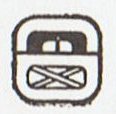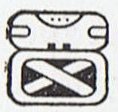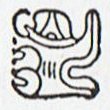6. If the first two glyph lines on side a should be meant to correspond to the sea voyage from the old land to the new, so to say, then the henua signs at the end of the 29 (or 31 if we count also the pair of 'open' henua) periods can be interpreted to refer to stations (pieces of land) on the new island, the 'land' which in early spring is rising in front of 'the canoe' as from 'the waves': ... The earth rises up from the sea again, and is green and beautiful and things grow without sowing ... The first such henua period could correspond to Hanga Te Pau:
After the explorers had gone ashore at Hanga Te Pau they 'moved backwards in time' by walking to Rano Kau with the surrounding 4 first kuhane stations (cfr at Time Travel):
10 days later, around June 20-21, it would be solstice, and i te angahuru o te ra (the 10th day) is perhaps used in the text of Manuscript E to allude to this fact. The top of the hill ought to mean the highest point in Sun's orbit across the sky, and they all climbed up there. North of the equator June is summer solstice. Maybe the story about the men going uphill was kept intact although it once was carried across the equator. On Easter Island June is still June, but it is winter and the month is He Maro. The explorers probably represent the planets (cfr at Toki) - whose orbits closely follow the path of Sun (the ecliptic) - and they therefore had to go uphill to follow the order of Sun:
In Mahabharata (north of the equator) there is a similar story about 4 brothers following their leader uphill: "... Yudhishtira, the eldest of the five Pandhavas, becoming weary of the world, resolves to retire from the sovereignty and acquire merit by pilgrimage. On hearing of his intentions his four brothers - Bhima, Arjuna, and the twins Nakula and Sahadeva - resolve to follow his example and accompany him. Yudhishtira appoints successors to his various kingdoms. The citizens and the inhabitants of the provinces, hearing the king's words, became filled with anxiety and disapproved of them. 'This should never be done' - said they unto the king. The monarch, well versed with the changes brought about by time, did not listen to their counsels. Possessed of righteous soul, he persuaded the people to sanction his views... The five brothers, with Draupadi forming the sixth [she was the joint wife of the brothers], and a dog forming the seventh, set out on their journey. The citizens and the ladies of the royal household followed them for some distance... The denizens of the city then returned. The seven pilgrims meanwhile had set out upon their journey. They first wandered eastward, then southward, and then westward. Lastly they faced northward and crossed the Himalaya. Then they beheld before them a vast desert of sand and beyond it Mount Meru. One by one the pilgrims sank exhausted and expired, first Draupadi, then the twins, then Arjuna, then Bhima; but Yudhishtira, who never even looked back at his fallen comrades, still pressed on and, followed by the faithful dog who turns out to be Dharma (the Law), in disguise, entered Heaven in his mortal body, not having tasted death ..." (Hamlet's Mill) If the region around Rano Kau represented winter solstice, then the explorers should go there in order to begin their work on the island at the beginning of the new year. Sun was about to reach his highest point on the other side of the equator, and then he would begin to move towards Easter Island. The kuhane stations could begin around winter solstice ('midnight'). With Sun going down in the west and coming up again in the east he must in between move under the earth from west to east. Only when he is visible does he move from east to west. Initially the kuhane of Hau Maka moved along the southern coast from west to east like Sun in the night. When in winter Sun is far away on the other side of the equator it is a similar situation - winter is like the night side of the year. At such a time Kuukuu heaped up earth, covered his yam roots as if with a black cloth, and a new house must be constructed: ... In the morning of the world, there was nothing but water. The Loon was calling, and the old man who at that time bore the Raven's name, Nangkilstlas, asked her why. 'The gods are homeless', the Loon replied. 'I'll see to it', said the old man, without moving from the fire in his house on the floor of the sea. Then as the old man continued to lie by his fire, the Raven flew over the sea. The clouds broke. He flew upward, drove his beak into the sky and scrambled over the rim to the upper world. There he discovered a town, and in one of the houses a woman had just given birth ... (cfr at Camp 4).
Maybe 'the large hole' of Rano Kau represents the origin of the Sun year, a hole leading from the previous year, and maybe the first pair of glyph lines on the front side of the G tablet tell about it. 
The first 16 glyphs in a line possibly correspond to the days in the first half-month and the rest to the days in the second half of the month. The Hawaiian Moon calendar had similarly 4 'stations' with 'ebb' at its end, beyond the 'flood' of the waning phase (cfr at Fishing Up Land):
The explorers sent out from the old homeland did not need to go back in time because there still remained 10 days to winter solstice when they had landed at Hanga Te Pau. But in order to begin their work at the proper place in space they anyhow 'went back in time'. The last glyph on side b could be the origin of the front side (cfr at Tamaiti):
The glyph type in Gb8-30 is puo, which means to cover up (like when yam roots are hilled up at dark winter solstice):
Probably we should contrast puo with the 'open mouth' (kai) sign, which indicates 'eating' and the resulting growth. Evidently also the Maya used an open mouth sign. All nature follows in the path of their leader (Sun) who is 'yawning' at the beginning of 'dawn' when the ecliptic once again is rising higher and higher in the sky and the sky is opening up to let in his light:
Glyph number 5 (as in 'fire' and Sun) on the front side is a vaha mea ('red opening'):
236 - 4 * 20 (Pop - Zotz) = 156 (= 6 * 26). Number 156 evidently is a sign for Mars (alias Kuukuu), cfr at Moe:
|
|||||||||||||||||||||||||||||||||||||||||||||||||||||||||||||||||||||||||||||||||||||||||||||||||||||||||||||||||||||||||||||||||||||||||||||||||||||||||||||||||||||||||||||||||












